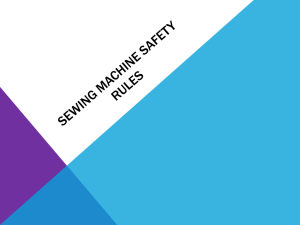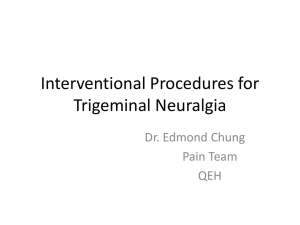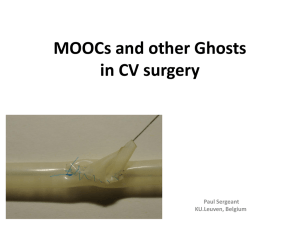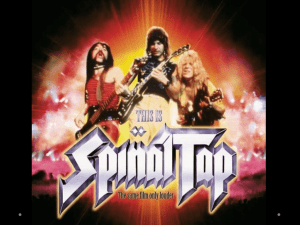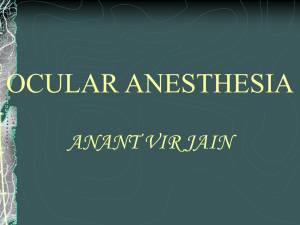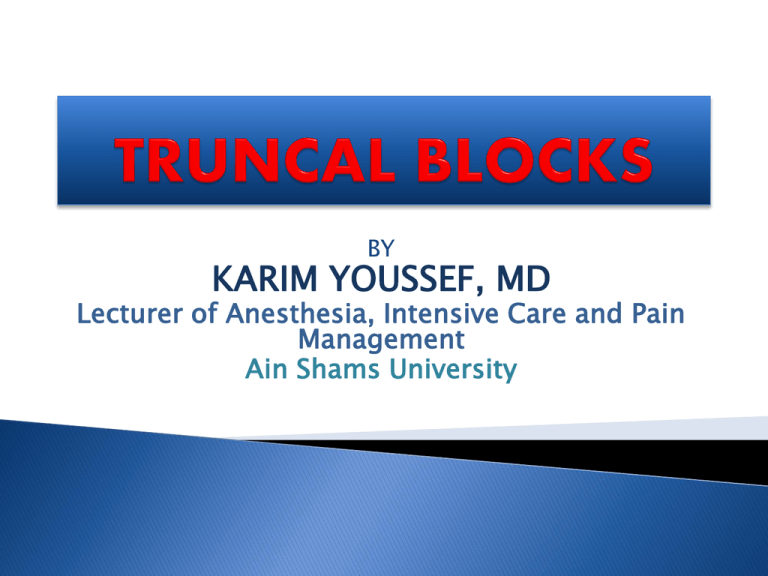
BY
KARIM YOUSSEF, MD
Lecturer of Anesthesia, Intensive Care and Pain
Management
Ain Shams University
Anatomy of the intercostal nerve
•
•
They are 12 pairs of thoracic anterior primary rami.
Intercostal nerves 3–6 (the ‘typical’ intercostal nerves)
They enter their intercostal spaces
across the anterior aspect of the
corresponding superior
costotransverse ligament to lie
below the intercostal vessels, first
between the posterior intercostal
membrane and the pleura and
then, at the rib angles, between
the internal intercostal and the
innermost intercostal muscles.
Near the margin of the sternum,
each nerve passes in front of the
internal thoracic vessels and
sternocostalis muscle and pierces
the internal intercostal muscle,
anterior intercostal membrane and
the overlying pectoralis major to
become an anterior cutaneous
nerve of the thorax.
The 1st intercostal nerve (T1) Passes across the front of the neck
of the 1st rib, lateral to the superior intercostal artery, to enter
into the composition of the brachial plexus.
The 2nd intercostal nerve: its lateral cutaneous branch crosses
the axilla to supply the skin of the medial aspect of the upper
arm (intercostobracbial nerve).
The 7th to 11th intercostal nerves enter the abdominal wall
between the interdigitations of the diaphragm with transversus
abdominis.
The 12th thoracic (subcostal) nerve runs along the lower border
of the 12th rib below the subcostal vessels, passes behind the
lateral arcuate ligament to run in front of quadratus lumborum
then passes between transversus abdominis and internal oblique.
Any pain from chest wall and
upper abdominal wall like:
Cancer pain.
Rib fractures.
Chronic painful inflammation
like herpes zoster.
Technique of intercostal nerve block
•
Patient is in prone position.
•By
index finger displace the
skin over rib in the posterior
axillary line .
•Needle
inserted perpendicular
to skin until bony contact with
the desired rib is made.
•The
needle is walked off the
lower edge of rib until bony
contact is lost, the needle is
advanced 3-5 mm deeper.
Pneumothorax:
Occur relatively in 1% to 2% of patients.
Local anesthetic toxicity:
Because of rapid absorption from this site.
Infection.
Unilateral
perioperative analgesia :
Cholecystectomy, renal or breast
op.
Upper extremity ischemic and
neuropathic pain, thoracic herpes
zoster, pancreatitis, and thoracic
cancer pain.
Lat. Or semiprone position.
Ipsilateral arm should hang across the body, retract
the scapula anteriorly.
Endpoint for entry into the interpleural space is
detection of negative interpleural pressure.
5~8th intercostal space, selected rib, 8~10cm lat.
to the midline.
Perpendicular to the skin, over rib, and walked
cephalad until contact the sup. Edge of rib is lost.
Passive loss of resistance.
Supine ; intercostal block with less
sympathetic block
Head up : Upper abdominal visceral pain
Head down : upper thoracic and cervical
spread
Lt. Side : pancreatic, gastric, or splenic
pain
Rt. Side : hepatic, gallbladder pain
Therapeutic dose : 20~30ml of
0.25~0.5% bupivacaine over 2~3minutes
Traumatic injury : Pneumothorax (2%),
catheter malposition.
Systemic effect from drug : Inflammation of
pleural membranes, local anesthetic
toxicity(1.3%), Pleural effusion (0.4%).
Etc. : Horner’s syndrome, phrenic n. palsy,
bronchopleural fistula formation, injury to
the neurovascular bundle.
POSTOPERATIVE
ANALGESIA:
Thoracic surgery
Breast surgery
Cholecystectomy
Renal and ureteric
surgery
Herniorrhaphy
Appendectomy
Video-assisted
thoracoscopic surgery
SURGICAL
ANESTHESIA:
Breast surgery
Herniorrhaphy
Chest wound
exploration
MISCELLANEOUS
•Fractured ribs
•Therapeutic control
of hyperhydrosis
•Liver capsule pain
after blunt trauma
•Acute postherpetic
neuralgia
Wedge shaped area on both
sides of vertebra
BOUNDARIES:
Anterior/lateral: Parietal
pleura
Posterior: Superior costotransverse ligament
Medial: Postero-lateral
aspect of the vertebral
body, intervertebral disc
and the intervertebral
foramen
COMMUNICATIONS:
Intercostal space laterally.
Epidural space medially.
Paravertebral space on
the other side via the
prevertebral and epidural
space.
Position : Sitting or
lateral decubitus,
with kyphotic
attitude supported
by a attendant.
Landmarks :
Spinous processes
along the midline
Tip of scapula :
T10
Paramedian line
2.5 cms lateral to
midline
At thoracic level :
Spinous process
of upper vertebrae
is at level of
transverse
process of lower
spine.
Needle Insertion
Point: 2.5 cm
lateral to the tip
of spinous
process.
Saggital section through the thoracic
paravertebral space showing a needle that
has been advanced above the transverse
process.
Procedure consists of 3
maneuvers
1.
Contacting transverse
processes of individual
vertebrae (depth 2-4
cms).
2.
Withdrawing needle to
skin level and
reinserting it 10 deg
caudal or cranial.
3.
Inserting needle 1 cm
deeper than level of
transverse processes.
Called “Walking Off”
(Cranially/Caudally)
Technique
The same method can be modified and a catheter
can be placed in the paravertebral space for
giving more prolonged postoperative analgesia.
A Touhy’s needle is used for the procedure and a
catheter is inserted 5 cms beyond the tip of the
needle.
Catheter is ideally inserted 1-2 segmental levels
below the thoracotomy incision.
Onset
(min)
Anesthesia
(hrs)
Analgesia
(hrs)
2% Lidocaine
(plus HCO3 +
epinephrine)
10-15
2-3
3-4
0.5%
Bupivacaine
(plus
epinephrine)
15-25
4-6
12-18
0.5% IBupivacaine
(plus
epinephrine)
12-25
4-6
12-18
Local Anesthetic: 3-4 ml/ level for multiple level block, 15-20
ml for single level, and infusion @ 0.1 ml/kg/h. Appropriate
drugs: bupivacaine 0.25-0.5%, ropivacaine 0.25-0.5%, or
lidocaine 1%; with epinephrine (2.5 μg/ml).
Mechanism and Spread of Anesthesia: 15 ml bupivacaine 0.5%
in TPVs produces unilateral somatic block over 5 (range: 1-9)
dermatomes, and sympathetic block over 8 (range 6-10)
dermatomes.
Possible areas of spread:
May remain localized
May spread to contiguous levels above and below
Intercostal space laterally
Epidural space, mostly unilateral and insignificant, in up to
70%
Single 15-20 ml injection as effective as multiple 3-4 ml/site.
Increasing volume may predispose to bilateral anesthesia
If a wide block (≥ 5 dermatomes) is desired, preferable to do
multiple injections, or 2 injections several dermatomes apart
ABSOLUTE
Infection at the site of
needle insertion.
Empyema.
Allergy to local
anesthetic drugs, and
Tumor occupying the
TPVS.
RELATIVE
Coagulopathy
Kyphoscoliosis (chest
deformity may
predispose to pleural
or thecal puncture)
Patient with previous
thoracotomy: TPVB
may be obliterated by
scar tissue and
adhesion of lung to
chest wall
Complications and ways to avoid them
Infection
- A strict aseptic technique should be used
Hematoma
- Avoid multiple needle insertions in anticoagulated patients
Local anesthetic
toxicity
- Rare
- Large volumes of long-acting anesthetic should be reconsidered in older
and frail patients
- Consider using chloroprocaine for skin infiltration to decrease the total
dose/volume of the more toxic, long-acting local anesthetic
Nerve injury
- Local anesthetic should never be injected when a patient complains of
severe pain or exhibits a withdrawal reaction on injection
Total spinal
anesthesia
- Avoid medial angulation of the needle, which can result in an inadvertent
epidural or subarachnoid needle placement
- Aspirate before injection (for blood and CSF)
Quadriceps muscle
weakness
- This can occur when the levels are not accurately determined and the
levels below L1 are blocked (femoral nerve; L2-4)
Paravertebral
muscle pain
-Paravertebral muscle pain, resembling a muscle spasm, is occasionally
seen, particularly in young, muscular men and when a larger gauge Tuohy
needle is used
- Injection of local anesthetic into the paravertebral muscle before needle
insertion and the use of a smaller gauge (e.g. 22 gauge) Quincke tip needle
is suggested to avoid this side effect
Anatomy of transversus abdominis plane
(TAP)
•The
anterior abdominal wall
(skin, muscles, parietal
peritoneum) is innervated by the
anterior rami T7 to T12 and L1.
•Terminal branches of them
course through the lateral
abdominal wall within a plane
between the internal oblique
and transversus abdominis
muscles.
•Injection of local anesthetic
within the TAP produce
unilateral analgesia to the skin,
muscles, and parietal
peritoneum.
For supplementary anesthesia
or analgesia for lower
abdominal surgery like:
Inguinal hernia.
Cesarean section.
•
Needle is inserted at triangle of Petit bounded
by the latissimus dorsi muscle posteriorly, the
external oblique muscle anteriorly and the iliac
crest inferiorly.
A needle is inserted perpendicular to enter
TAP plane after two pops.
The first pop: penetration of the external
oblique fascia.
The second pop: penetration of internal oblique
muscle.
•
Ulrasound guided technique for
TAP block
Patient is placed in a supine position
and the abdomen is exposed between
the costal margin and the iliac crest.
•
Identify the three muscular layers of
the abdominal wall: the external
oblique (most superficial), the internal
oblique and transversus abdominis
muscles.
•
Among the three muscles, the
internal oblique muscle is the most
prominent layer.
•
Ultrasound guided TAP block (cont)
•Needle
is inserted in-plane with the
transducer, in an antero-posterior
direction.
•Choosing
an insertion point some
distance away from the transducer
improves needle shaft and tip
visualization.
•Deposit
local anesthetic deep to the
fascial layer that separates the
internal oblique and transversus
abdominis muscles.
Innervation of the inguinal region lumbar plexus nerves:
Ilioinguinal, Iliohypogastric nerves (L1).
Genitofemoral nerve (L1,L2).
These nerves coarse anteriorly near an important landmark for
the block , the anterior superior iliac spine.
The ilioinguinal nerve lies between the transversus abdominis
muscle and the internal oblique muscle initially and then
penetrates the internal oblique muscle some distance medial to
the anterior superior iliac spine.
The iliohypogastric nerve lies between the internal and external
oblique muscles near the anterior superior iliac spine.
The genitofemoral nerve follows a different coarse, and it is this
nerve that must often be supplemented intraoperatively.
All these nerves continue anteriorly in a medial orientation and
become superficial as they terminate in the skin and muscles of
the inguinal region.
Course of the ilioinguinal, iliohypogastric, and genitofemoral nerves.
The anterior superior iliac spine (ASIS)
should be marked while the patient is
supine. Another mark should be made
approx. 3 cm. medial and inferior to the
ASIS.
A skin wheal is created, and a 8-cm,
22-gauge needle is inserted in a
cephalolateral direction to contact the
inner surface of ilium. 10 mm of local
anesthetic is injected as the needle is
slowly withdrawn through the layers of
the abdominal wall.
The needle should then reinserted at a
steeper angle to ensure penetration of
the three muscle layers.
From the previously placed skin wheal,
the injection is extended toward the
umbilicus, creating a subcutaneous
field block.
Celiac plexus is situated retroperitoneally in
paravertebral areolar tissue at anterolateral
edge of the first lumbar vertebra on both
sides.
It lies posterior to the stomach and pancreas,
anterior to the crura of diaphragm and the
aorta.
The numbar of ganglia varies from 1 to 5 on
both sides.
It receives afferent fibers of both sympathetic
and parasympathetic from viscera.
The celiac plexus provides innervation to most
of the gut from the lower esophagus to the
level of the splenic flexure of the colon.
Cancer from upper abdomen:
cancer stomach or pancreas.
•
Chronic non malignant pain
from upper abdomen
•
Classic retrocrural technique
(deep splanchnic approach)
Triangle is made between 3 points:
spine between T 12 & L 1 and lower
edges of 12th rib on both sides.
• Needle is inserted just cauded to 12th
rib 7 cm lateral to midline, 45 degree
from horizontal plane & 15 degree
cephaled until bony contact with L1
vertebral body is made.
• Needle is withdrawn & redirected
laterally about 1-2 cm, at this point
aortic pulsations may be felt and the
local anesthetic is injected retroaortic.
•
Posterior
approaches:
Classic Retrocrural (Deep splanchnic) Approach
Transcrural (Antecrural) Celiac Block
Transaortic Celiac Neurolysis
Transintervertebral Disc approach
Anterior approaches:
Intraoperative Celiac Neurolysis
Percutaneous Anterior Celiac Neurolysis
Transcatheter Neurolysis
Endoscopic ultrasound-Guided Celiac
Plexus
Block
Anatomy of superior hypogastric nerve
•The
superior hypogastric plexus
is a retroperitoneal structure that
extends bilaterally anterior to the
vertebral column between L5 and
S1 vertebral bodies.
•It
is formed by pelvic visceral
afferents and efferent
sympathetic nerves from
branches of the aortic plexus,
and fibers from the splanchnic
nerves.
•It
divides into two lateral
portions which travel inferiorly to
end as inferior hypogastric
plexus.
Any pain from:
Lower urinary tract: bladder & urethra.
Lower GIT: descending colon & rectum.
Female genital tract: uterus, vagina &
vulva.
Male genital tract: prostate, penis
&testes.
Perineum.
Technique of superior
hypogastric block
•The
patient will be in
prone position.
Needle is introduced 6 cm
lateral to spine of L4.
•
Directed 45 degrees
medial and caudal until its
tip comes anterior to
vertebral body of L5 under
fluoroscopic guidance.
•
Anatomy of the ganglion Impar
•The
ganglion impar is the
only unpaired autonomic
ganglion in the body.
•Marks
the end of the two
sympathetic chains.
•Located
retroperitonially
anterior to the
sacrococcygeal joint.
Any pain from:
Perineum.
Distal
rectum & anus.
Distal urethra.
Distal third of vagina & vulva.
Prostate & testes.
Technique of ganglion Impar block
•
The patient in the prone position.
Needle is inserted in the sacral
cornu to pierce the dorsal
sacrococcygeal ligament at the
midline.
•
The needle is then advanced to
pierce the ventral sacrococcygeal
ligament, felt as a loss of
resistance.
•
Patient position in intercostal nerve block can be:
a)
b)
c)
d)
Prone.
Lateral.
Supine.
All of the above.
One of important indications of paravertebral block:
a)
b)
c)
d)
Patients in whom neuroaxial techniques may be
containdicated owing to hypotension or coagulopathy.
Infection at site of injection.
Allergy to local anesthetic.
Tumor in paravertebral space.
Triangle of Petit boundaries are:
a)
b)
c)
d)
Latissmus dorsi, iliac crest, external oblique.
Latissmus dorsi, internal oblique, transversus abdominis.
External oblique, internal oblique, latissmus dorsi.
Transversus abdominis, iliac crest, external oblique.
Nerves that supply inguinal region:
a)
b)
c)
d)
Ilioinguinal, iliohypogastric, genitofemoral
Lateral cutaneous nerve of thigh, ilioinguinal, obturator.
Iliohypogastric, genitofemoral, sciatic
Femoral, dorsal nerve of penis, ilioinguinal.
Celiac plexus is situated retroperitoneally at
anterolateral edge of:
a)
b)
c)
d)
L1
L4
L5
S1




